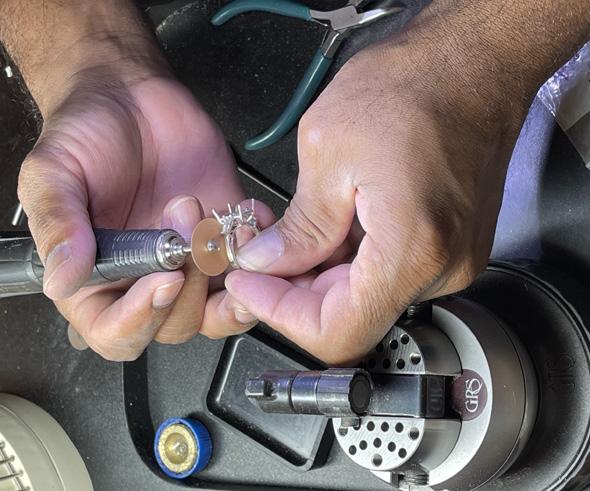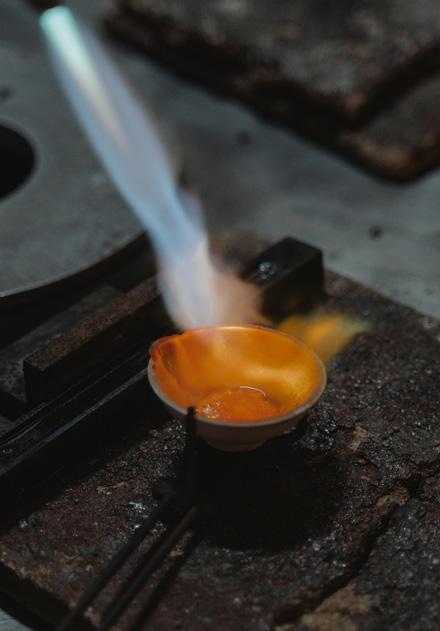
5 minute read
Lab Grown Diamonds
A Guide to Lab-Grown Diamonds:
Production, Grading, and Shopping
Advertisement
One of the most common questions we hear from clients is, “Are lab diamonds real?” The answer is a resounding yes. Lab-grown diamonds are real diamonds in every sense. They have the same physical and chemical properties as a diamond mined from the earth.
Lab-grown diamonds have enjoyed greater popularity in the past few years, thanks to their environmental and ethical impact. Kravit Jewelers walks you through the sublime beauty and mystery of a lab diamond and what makes it deserving of the spotlight as its natural sister.
LAB-GROWN VS. NATURAL DIAMONDS Lab-grown diamonds, also known as man-made, cultured, or lab-diamonds, are created in a laboratory environment. It’s different from a natural or earth-mined diamond, which is formed over about a billion years. Although they have different origins, a lab-grown diamond has the same chemical and physical properties as a natural diamond: · Chemical Composition. Both types of diamond are made of pure crystallized carbon (where each carbon atom is surrounded by four other carbon atoms, connected by covalent bonds) · Hardness. Both are rated 10 on the Mohs Hardness Scale, making them the hardest substances on Earth. · Density. Both have a density of 3.51g/cm3 · Refractive Index. Both have a refractive index of 2.42. · Fire or Light Dispersion. Both have a light dispersion of 0.044. · Colors. Both range from D (colorless) to Z (yellow). They also come in fancy colors. In essence, lab diamonds are real diamonds. They’re not “fake gems.” They’re not moissanites, cubic zirconias, or imitation diamonds. You’re getting the real deal. Additionally, it’s inaccurate to call natural diamonds “real diamonds” because their lab-grown counterparts are true gems, too. The only difference between a lab-grown and natural diamond is where they came from.

How Lab-Grown Diamond Are Made
Before we discuss the production of lab-grown diamonds, we have to explore how earth-mined diamonds are formed.
FORMATION OF NATURAL DIAMONDS Natural diamonds are formed deep in the Earth’s mantle — about 100 miles beneath the surface. Carbon atoms in this region (which many believe are in the form of carbon dioxide) are subjected to extreme heat (upwards of 2,200°F) and pressure (around 727,000 pounds per square inch). A diamond gradually forms in this extreme environment over a period of 1 to 3.3 billion years. These diamonds are then transported near the surface of the Earth through deep-sources volcanic eruptions. These eruptions tear through the mantle, delivering rocks known as xenoliths, containing the diamonds that people mine today. This complex process explains the princely price tags of natural diamonds. They’re rare, and it takes a billion years to replace one. As such, people resorted to technology to produce gem-quality lab-grown diamonds.
PRODUCTION OF LAB DIAMONDS There are two main ways to produce lab diamonds.
High-Pressure High-Temperature
High-Pressure High-Temperature (HPHT) processes simulate the environment in which a diamond forms. The technicians place a diamond seed (a single crystal from a diamond about as thick as a human hair) into pure carbon and expose them to extreme temperature and pressure. The pure carbon then melts and forms a diamond around the diamond seed. It’s then cooled, and a lab diamond is formed.
Chemical Vapor Deposition
Chemical Vapor Deposition (CVD) also begins with a diamond seed placed in a chamber and exposed to high heat. Technicians then fill the chamber with a carbon-rich gas. The gases undergo ionization, which breaks the bonds between the carbon and other atoms. The pure carbon then adheres to the seed, forming a lab-grown diamond. Compared to a billion-year-old natural diamond formation, labgrown diamonds take less than a month to produce. Many laboratories can produce a 1-carat diamond in a little over a week.

Why Buy Lab-Grown?
1 Lower Price Tag
On average, lab-grown diamonds are more affordable than earthmined diamonds. The latter has a longer supply chain; they are mined, distributed, and processed. In contrast, lab diamonds don’t involve a mining process. That said, lab-grown diamonds are still relatively expensive. The costs of cutting, polishing, grading, and setting a diamond, earth-mined or lab-grown, are high.
2 Environment-Friendly
Because lab-grown diamonds don’t involve mining, they have a significantly lower environmental impact than their natural counterparts. Although gem-mining companies have improved their mining practices and reduced their environmental effects, lab-diamond production is still far less detrimental. It’s also important to note that it takes a lot less energy to grow a diamond than to mine one.
3 Ethical Provenance
Shoppers have the assurance that lab-grown diamonds are conflict-free and ethically produced. Because the diamonds are grown in a laboratory setting, consumers are confident that no miners or communities were exploited in the process.
Lab Grown Diamonds THINK BIGGER



The Kravit Jewelers card is issued by Synchrony Bank. The Kravit Jewelers Preferred Financing Program provides the flexibility to help your dreams come true. Our convenient and fast approval process makes it easy and safe to apply online at KRAVITJEWELERS.COM or in store. Let our extraordinary selections, service, quality and values earn your trust for a lasting relationship with us.


Trusted For Over 90 Years




Behind the scenes of Kravit Jewelers storefront exists a bustling world of craftspeople, each dedicated to your watch and jewelry needs. With a deep understanding of what makes a quality piece of jewelry, Kravit Jewelers isn’t just the finest jewelers, it’s the most trusted.











